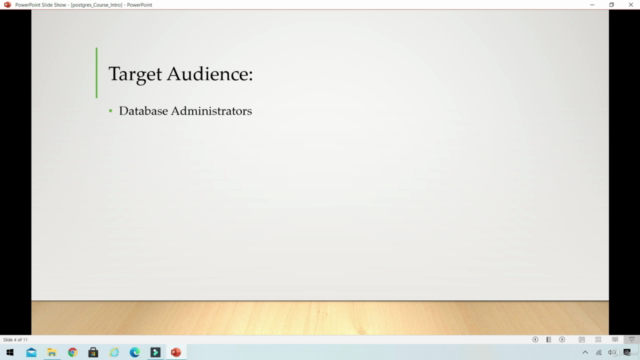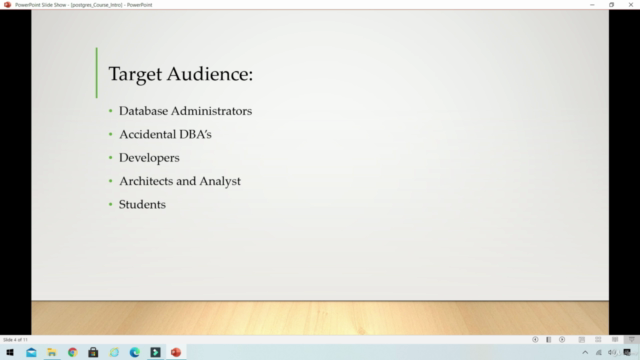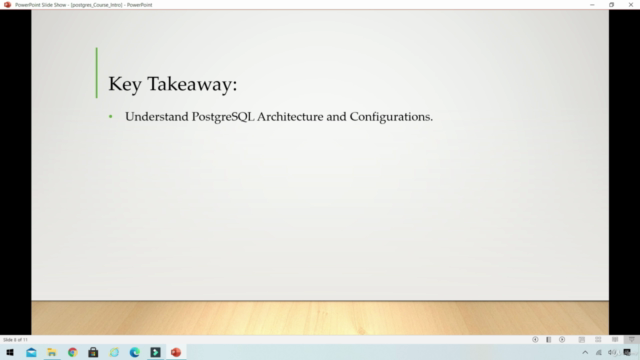PostgreSQL Database Administration on Windows/Linux- Part 1

Why take this course?
🌟 Walk-in a Beginner, Walk-Out an Expert: PostgreSQL Database Administration [Updated with Latest PostgreSQL V16] 🌟
Unlock the Power of PostgreSQL on Windows/Linux!
🚀 Course Overview: PostgreSQL is a robust and open-source Object-Relational Database Management System (ORDBMS) that stands out for its advanced features like MVCC, point-in-time recovery, and support for both SQL and JSON querying. It's designed to handle large volumes of data with concurrent access, making it the go-to solution for businesses and developers who demand reliability and performance from their databases.
🔍 What You Will Learn: This comprehensive course is tailored to take you from a beginner to an expert in PostgreSQL Database Administration. With real-time examples and hands-on practice, you'll gain extensive knowledge of PostgreSQL's architecture, installation, configuration, and administration on both Windows and Linux platforms.
Key Topics include:
-
PostgreSQL Process and Memory Architecture: Dive deep into the internal workings of PostgreSQL to understand how it manages memory and processes for optimal performance.
-
Installation of PostgreSQL v12 - Windows and Linux: Get hands-on experience installing the latest version of PostgreSQL on both Windows and Linux systems.
-
Setup PostgreSQL v12 Environment Variables - Windows and Linux: Learn how to configure the environment to ensure PostgreSQL runs smoothly on your system.
-
PostgreSQL Page Layout: Explore the physical structure of a PostgreSQL database page.
-
Database Directory Layout: Understand how PostgreSQL organizes data storage directories and files for efficient data management.
-
PostgreSQL Configuration Files: Discover the key configuration settings that affect performance, security, and behavior of your PostgreSQL setup.
-
Cluster in PostgreSQL (Initdb,Start/Stop,Reload/Restart Cluster): Master setting up a new cluster with
initdb, managing its lifecycle withpg_ctl, and ensuring high availability. -
Createdb/Dropdb, Createuser/Dropuser Utility: Learn to manage databases and users with ease using PostgreSQL's utilities.
-
Create Schema and Schema Search Path: Understand the organization of schemas in PostgreSQL and how to manage search paths for better data access control.
-
Psql Interface Commands: Become proficient with
psql, the PostgreSQL command-line interface, for interacting with your databases. -
Pg System Catalogs: Use system catalogs to monitor and manage database performance and structure.
-
Working with PostgreSQL Objects: Learn how to create, modify, and manage tables, views, and other PostgreSQL objects.
-
CRUD Operations: Master Create, Read, Update, and Delete operations within your PostgreSQL environment.
-
Table Inheritance: Understand and implement table inheritance for more efficient data modeling.
-
Table Partitioning: Learn how to partition tables to enhance performance and manage large datasets effectively.
-
Tablespace in PostgreSQL: Manage the physical storage of database objects with tablespaces.
-
Backup, Continuous Archiving, and PITR (Point-in-Time-Recovery): Protect your data by learning how to perform backups, set up continuous archiving, and recover from failures with PITR.
-
Explain plan and Query Execution Cost: Optimize your queries' performance using explain plans and understand the costs associated with them.
-
Maintenance (Updating Planner Statistics, Vacuum, Routine Reindex & Cluster): Keep your database performing at its best with regular maintenance tasks.
-
Data Fragmentation: Identify and resolve fragmented data to maintain optimal performance.
-
Transaction ID wraparound, Vacuum freeze, Auto_Vacuum Demon: Understand the PostgreSQL transaction model and how to use vacuuming to maintain a healthy database.
-
Pgadmin 4: Explore the features of
pgAdmin 4, the ultimate tool for managing PostgreSQL databases.
🔄 Stay Updated with the Latest Versions: This course is regularly updated to reflect the newest versions and features of PostgreSQL, ensuring you stay ahead of the curve. As of now, we're focused on PostgreSQL V16!
Join us on this journey to master PostgreSQL Database Administration! Whether you're new to databases or looking to expand your skillset, this course provides the knowledge and hands-on practice you need to excel. 🏅
Enroll now and transform your database administration skills with PostgreSQL!
Course Gallery




Loading charts...
Comidoc Review
Our Verdict
Explore the fundamentals of PostgreSQL administration in this expertly-crafted course, but prepare for occasional challenges stemming from subtitle inconsistencies, demonstration errors, and varying screen visibility. Enhancements to organization and technical specifics would elevate this valuable learning experience further, particularly when addressing real-world scenarios like database replication and upgrades. A worthwhile endeavor for PostgreSQL beginners ready to commit time and energy towards understanding the latest features through v16.
What We Liked
- The course provides a thorough explanation of PostgreSQL concepts, going beyond just how-to instructions and clarifying why certain procedures are done.
- Demonstrations are clear and informative, with some background details shown to enhance understanding.
- Well-structured sessions and demo sessions cater effectively to new learners, providing crisp examples that make the content easily comprehensible.
- The course layout covers a wide range of PostgreSQL topics in detail and is further enhanced by additional documents and modules on newer PostgreSQL versions.
Potential Drawbacks
- There's some repetition in the content, with a significant portion dedicated to reading PowerPoint slides verbatim.
- The course could benefit from improved screen visibility, as small font sizes hinder Windows demo understanding.
- Occasionally, there are discrepancies between spoken words and auto-generated subtitles which might cause confusion.
- A handful of demonstration errors were noted, and certain topics like logical replication during upgrades could be expanded upon.